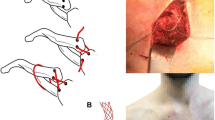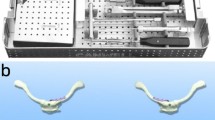Abstract
Background
Surgical treatment options for sternoclavicular joint luxations described in the literature are numerous, although all have limitations. Therefore, there is no favorable surgical treatment for sternoclavicular luxations when nonoperative treatment has failed.
Description of Technique
We developed the polydioxanone (PDS) envelope plasty, a modification of the figure-of-eight technique, using a PDS ligament.
Methods
We retrospectively reviewed 39 patients (40 joints), treated with a PDS envelope plasty for invalidating sternoclavicular luxations. The minimum followup was 10 months (average, 52 months; range, 10–171 months). The Simple Shoulder Test (SST), Constant-Murley shoulder score, and subjective categorical results were recorded preoperatively and postoperatively.
Results
In most patients, postoperative functional shoulder scores were excellent (mean Constant-Murley score, 90, range, 52–100; mean SST, 10; range, 2–12). Ninety percent of patients had an improvement of shoulder function at followup. Only minor complications occurred. Thirteen percent of patients had spontaneous postoperative subluxations. However, the postoperative shoulder function improved in all these patients.
Conclusions
The PDS envelope plasty is a simple procedure, a modification of the best-reported technique. We have promising results with high shoulder scores.
Level of Evidence
Level IV, therapeutic study. See Guidelines for Authors for a complete description of levels of evidence.



Similar content being viewed by others
References
Abiddin Z, Sinopidis C, Grocock CJ, Yin Q, Frostick SP. Suture anchors for treatment of sternoclavicular joint instability. J Shoulder Elbow Surg. 2006;15:315–318.
Acus RW 3rd, Bell RH, Fisher DL. Proximal clavicle excision: an analysis of results. J Shoulder Elbow Surg. 1995;4:182–187.
Armstrong AL, Dias JJ. Reconstruction for instability of the sternoclavicular joint using the tendon of the sternocleidomastoid muscle. J Bone Joint Surg Br. 2008;90:610–613.
Bae DS, Kocher MS, Waters PM, Micheli LM, Griffey M, Dichtel L. Chronic recurrent anterior sternoclavicular joint instability: results of surgical management. J Pediatr Orthop. 2006;26:71–74.
Cave EF. Shoulder girdle injuries. In Cave EF, ed. Fractures and Other Injuries. Chicago, IL: Year Book Publishers; 1958:258–259.
Constant CR, Murley AH. A clinical method of functional assessment of the shoulder. Clin Orthop Relat Res. 1987;214:160–164.
de Jong KP, Sukul DM. Anterior sternoclavicular dislocation: a long-term follow-up study. J Orthop Trauma. 1990;4:420–423.
Dürselen L, Dauner M, Hierlemann H, Planck H, Claes LE, Ignatius A. Resorbable polymer fibers for ligament augmentation. J Biomed Mater Res. 2001;58:666–672.
Féry A, Sommelet J. Dislocation of the sternoclavicular joint. Int Orthop. 1988;12:187–195.
Franck WM, Jannasch O, Siassi M, Hennig HF. Basler plate stabilization: an alternate therapy for traumatic sternoclavicular instability. J Shoulder Elbow Surg. 2003;12:276–281.
Gerlach D, Wemhoner SR, Ogbuihi S. [2 cases of pericardial tamponade caused by migration of fracture wires from the sternoclavicular joint] [in German]. Z Rechtsmed. 1984;93:53–60.
Glass ER, Thompson JD, Cole PA, Gause TM, Altman GT. Treatment of sternoclavicular joint dislocations: a systematic review of 251 dislocations in 24 case series. J Trauma. 2011;70:1294–1298.
Groh GI, Wirth MA. Management of traumatic sternoclavicular joint injuries. J Am Acad Orthop Surg. 2011;19:1–7.
Hessmann M, Gotzen L, Gehling H, Rüschenpöhler D. [Results of reconstruction of acromioclavicular joint rupture with PDS implants] [in German]. Unfallchirurg. 1997;100:193–197.
Jaggard MK, Gupte CM, Gulati V, Reilly P. A comprehensive review of trauma and disruption to the sternoclavicular joint with the proposal of a new classification system. J Trauma. 2009;66:576–584.
Martinez A, Rodriguez A, Gonzales G, Herrera A, Domingo J. Atraumatic spontaneous posterior subluxation of the sternoclavicular joint. Arch Orthop Trauma Surg 1999;119:344–346.
Panzica M, Zeichen J, Hankemeier S, Gaulke R, Krettek C, Jagodzinski M. Long-term outcome after joint reconstruction or medial resection arthroplasty for anterior SCJ instability. Arch Orthop Trauma Surg. 2010;130:657–665.
Rockwood C, Groh GI, Wirth MA, Grassi FA. Resection arthroplasty of the sternoclavicular joint. J Bone Joint Surg Am. 1997;79:387–393.
Rockwood CA, Odor JR. Spontaneous atraumatic subluxation of the sternoclavicular joint. J Bone Joint Surg Am. 1989;71:1280–1288.
Salvatore JE. Sternoclavicular joint dislocation. Clin Orthop Relat Res 1968;58:51–55.
Spencer EE, Kuhn JE. Biomechanical analysis of reconstructions for sternoclavicular joint instability. J Bone Joint Surg Am. 2004;86:98–105.
Tashjian RZ, Deloach J, Green A, Porucznik CA, Powell AP. Minimal clinically important differences in ASES and simple shoulder test scores after nonoperative treatment of rotator cuff disease. J Bone Joint Surg Am. 2010;92:296–303.
Thomas DP, Williams PR, Hoddinott HC. A “safe” surgical technique for stabilization of the sternoclavicular joint: a cadaveric and clinical study. Ann R Coll Surg Engl. 2000;82:432–435.
Thut D, Hergan D, Dukas A, Day M, Sherman OH. Sternoclavicular joint reconstruction: a systematic review. Bull NYU Hosp Jt Dis. 2011;69:128–135.
van Kampen DA, van Beers LW, Scholtes VA, Terwee CB, Willems WJ. Validation of the Dutch version of the Simple Shoulder Test. J Shoulder Elbow Surg. 2012;21:808–814.
Venissac N, Alifano M, Dahan M, Mouroux J. Intrathoracic migration of Kirschner pins. Ann Thorac Surg. 2000;69:1953–1955.
Author information
Authors and Affiliations
Corresponding author
Additional information
The institution of the authors has received, during the study period, funding from Stryker Benelux, (Koeweistraat 8, 4180 BA Waardenburg, Netherlands).
All Conflict of Interest Forms for authors and Clinical Orthopaedics and Related Research editors and board members are on file with the publication and can be viewed on request.
Clinical Orthopaedics and Related Research neither advocates nor endorses the use of any treatment, drug, or device. Readers are encouraged to always seek additional information, including FDA approval status, of any drug or device before clinical use.
Each author certifies that his or her institution approved or waived approval for the human protocol for this investigation and that all investigations were conducted in conformity with ethical principles of research.
About this article
Cite this article
Gardeniers, J.W.M., Burgemeester, J., Luttjeboer, J. et al. Surgical Technique: Results of Stabilization of Sternoclavicular Joint Luxations Using a Polydioxanone Envelope Plasty. Clin Orthop Relat Res 471, 2225–2230 (2013). https://doi.org/10.1007/s11999-013-2890-1
Received:
Accepted:
Published:
Issue Date:
DOI: https://doi.org/10.1007/s11999-013-2890-1




